Dreamy Striped Crab Ravioli With A Sage Butter Sauce Recipe
Crafting delectable striped crab ravioli demands creativity and passion for culinary excellence.
Delicate pasta sheets embrace sweet, tender crab meat with elegant precision.
Mediterranean influences shimmer through each handmade pocket of flavor.
Silky sage butter provides a luxurious coating that amplifies seafood’s natural richness.
Professional chefs and home cooks alike appreciate complex yet accessible dishes like this.
Fresh ingredients make all the difference when preparing such an impressive plate.
Prepare to impress your guests with this sophisticated, restaurant-quality meal that celebrates ocean-inspired cuisine.
Striped Crab Ravioli with Sage Butter Sauce
Ingredients to Prepare Crab Ravioli
Pasta Ingredients:Filling Ingredients:Sauce Ingredients:How to Make Striped Crab Ravioli with Sauce
Step 1: Create Pasta Dough Base
Form a flour mountain on a clean surface. Dig a deep well in the center and crack eggs into the middle.
Sprinkle salt over the eggs. Gently beat eggs with a fork, gradually blending flour until a wet dough emerges.
Step 2: Develop Pasta Dough Texture
Use a bench scraper to incorporate remaining flour. Rotate dough 45 degrees with each fold.
Knead by pressing forward with your hand’s heel. Continue until dough becomes smooth and elastic.
Check for air pockets by cutting a small slice.
Step 3: Prepare Squid Ink Variation
Separate dough into three equal portions.
Keep two pieces wrapped. Add squid ink to the third piece, kneading thoroughly.
If dough becomes too wet, dust with flour. Cover and let rest for 30 minutes.
Step 4: Mix Ravioli Filling
Combine in a mixing bowl:Mix ingredients until well incorporated.
Step 5: Roll Out Plain Pasta Sheets
Cut plain dough into three sections.
Roll out first section on floured surface. Pass through pasta machine on widest setting three times.
Fold and roll repeatedly to develop smooth texture.
Step 6: Create Striped Pasta Design
Roll out squid ink pasta section.
Cut into 14-inch segments. Use fettuccine attachment to create black pasta strips.
Layer black strips onto plain pasta sheets. Press gently with rolling pin.
Step 7: Thin Pasta Sheets
Continue passing striped pasta through machine, reducing width until nearly translucent. Aim for approximately 1/16-inch thickness.
Step 8: Cut Pasta Circles
Use circular cookie cutter to create 3-inch pasta disks. Discard excess dough.
Step 9: Assemble Ravioli
Place crabmeat filling in center of half the pasta circles. Brush water around edges.
Top with matching pasta disk. Press edges firmly to seal.
Ensure stripes align.
Step 10: Prepare Sage Butter Sauce
Melt butter in skillet over medium-high heat.
Cook until golden brown. Add sage leaves.
Remove from heat. Stir in fresh lemon juice.
Step 11: Cook and Serve
Boil salted water. Cook ravioli until they float, about 2 minutes.
Transfer to sage butter sauce. Gently coat ravioli.
Serve immediately while hot.
Tips to Perfect Crab Ravioli Every Time
Variations to Change Up Crab Ravioli
Pairings That Compliment Crab Ravioli
Proper Storage Tips for Crab Ravioli
FAQs
The squid ink pasta dough is cut into strips and carefully layered onto plain pasta sheets, then pressed together with a rolling pin to create a distinctive black and white striped pattern.
Check the dough by slicing it open with a paring knife. If few to no air bubbles are present and the dough has a smooth, elastic texture, it’s ready. If many air bubbles exist, continue kneading.
Yes, you can prepare the pasta dough in advance. After kneading, wrap the dough in plastic wrap and let it rest at room temperature for up to 30 minutes, or refrigerate for a few hours before using.
Print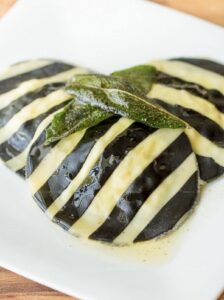
Striped Crab Ravioli With A Sage Butter Sauce Recipe
- Total Time: 1 hour 10 minutes
- Yield: 4 1x
Description
Italian chefs master this striped crab ravioli with sage butter sauce, creating delicate pasta parcels filled with sweet crab meat. Silky sauce and handcrafted pasta invite diners to savor coastal Mediterranean flavors with elegant simplicity.
Ingredients
- 2 cups all-purpose flour (plus more for dusting)
- 2 eggs
- 4 egg yolks
- 1 tsp kosher salt
- 1½ tsp squid ink
- 1 cup lump crabmeat
- 1 cup ricotta
- 4 tbsps unsalted butter
- 8 sage leaves
- 1/2 lemon (juiced)
- salt (to taste)
- pepper (to taste)
Instructions
- Create a flour mound on a clean work surface, forming a central well. Crack eggs and add salt into the well, using a fork to gradually incorporate flour until a wet dough forms.
- Use a bench scraper to fold remaining flour into the dough, rotating 45 degrees with each fold to create a firm consistency.
- Knead the dough by pressing with the heel of your hand, turning 45 degrees repeatedly until achieving a smooth, elastic texture. Check for air bubbles by cutting the dough; continue kneading if needed. Adjust moisture by wetting hands or adding flour.
- Divide dough into three equal pieces. Combine two pieces and cover with plastic wrap. Mix squid ink into the remaining portion, kneading until fully incorporated. Rest both dough sections for 30 minutes.
- Prepare a floured parchment-lined baking sheet for pasta sheets.
- Mix ricotta, crabmeat, salt, and pepper in a bowl, then set aside.
- Divide plain dough into three sections, keeping two covered.
- Roll out one dough section into a ½-inch thick rectangle. Pass through pasta attachment’s widest setting three times.
- Fold dough ends to meet in the middle, then fold in half. Roll and pass through attachment again, repeating the folding process.
- Gradually reduce pasta attachment width, creating thin sheets. Place on parchment paper and cover to prevent drying.
- Repeat the rolling process with remaining plain dough sections.
- Cut squid ink dough into 14-inch segments. Create stripe pattern by feeding through fettuccini attachment and layering on plain pasta sheets.
- Continue thinning pasta sheets until nearly translucent, approximately 1/16-inch thick.
- Cut pasta sheets into 3-inch diameter circles using a cookie cutter.
- Assemble ravioli by placing filling in pasta disk centers. Brush edges with water, top with another disk, ensuring stripe alignment. Press edges to seal.
- Bring a large, salted water pot to boil.
- Create sage butter sauce by melting butter over medium-high heat until golden-brown. Add sage leaves and remove from heat. Stir in lemon juice.
- Cook ravioli in boiling water for 2 minutes until they float. Transfer to sage butter sauce, gently coating, and serve immediately.
Notes
- Select high-quality crabmeat for a rich, sweet flavor that elevates the entire dish’s taste profile.
- Keep pasta sheets covered with plastic wrap or damp towel to prevent drying during preparation, which can cause cracking and uneven texture.
- Consider gluten-free flour alternatives like almond or rice flour for those with wheat sensitivities, ensuring the pasta maintains a smooth, elastic consistency.
- Allow extra time for kneading squid ink pasta dough, as the ink can make the mixture slightly more challenging to incorporate uniformly compared to plain pasta.
- Prep Time: 1 hour
- Cook Time: 10 minutes
- Category: Lunch, Dinner, Appetizer
- Method: Boiling
- Cuisine: Italian
Nutrition
- Serving Size: 4
- Calories: 390 kcal
- Sugar: 1 g
- Sodium: 260 mg
- Fat: 22 g
- Saturated Fat: 12 g
- Unsaturated Fat: 8 g
- Trans Fat: 0.2 g
- Carbohydrates: 30 g
- Fiber: 1 g
- Protein: 18 g
- Cholesterol: 195 mg

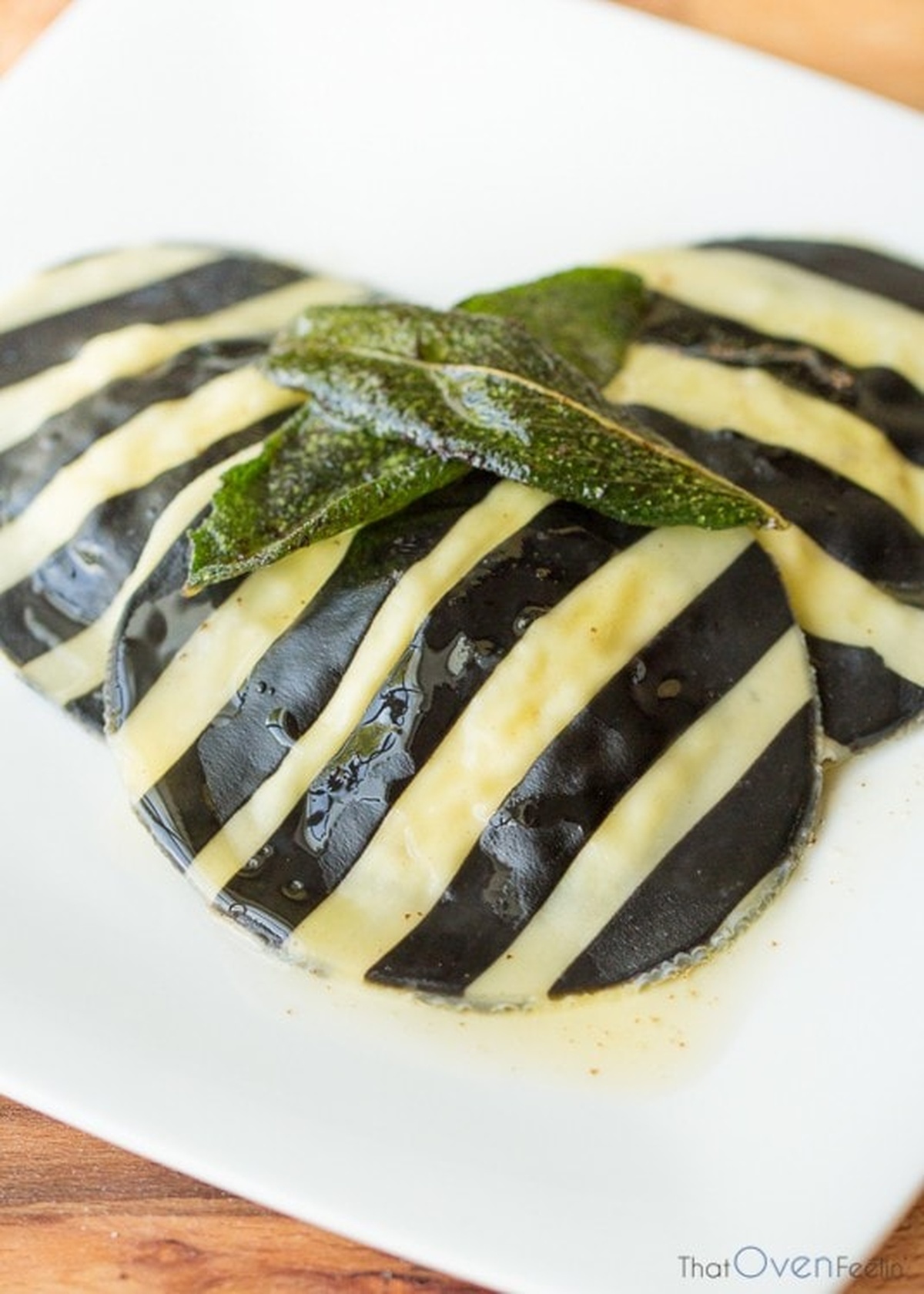
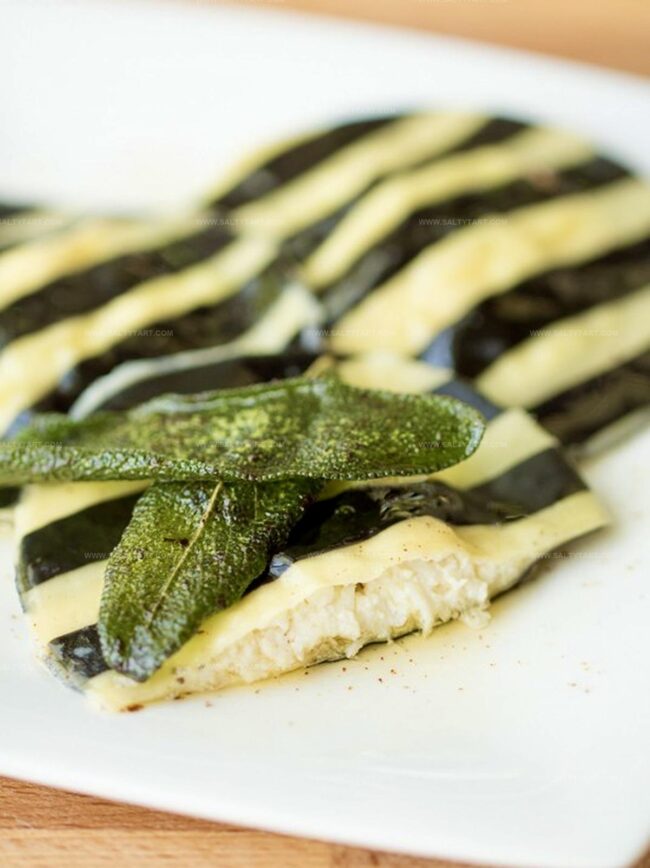
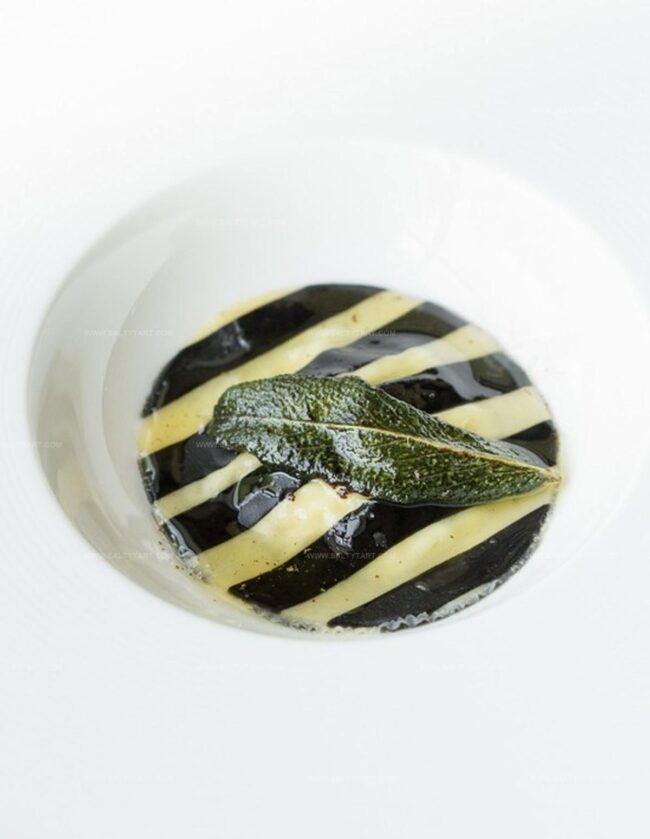
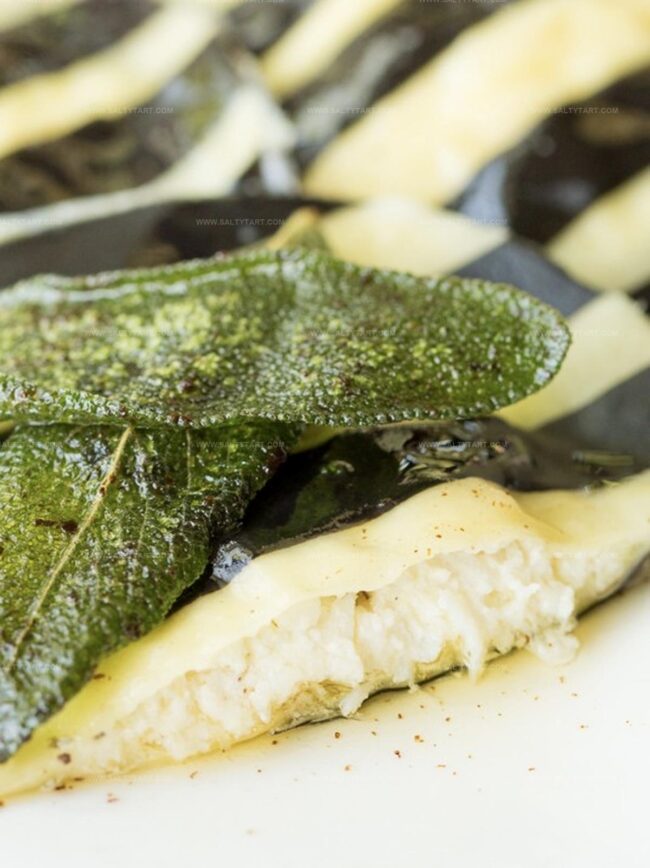
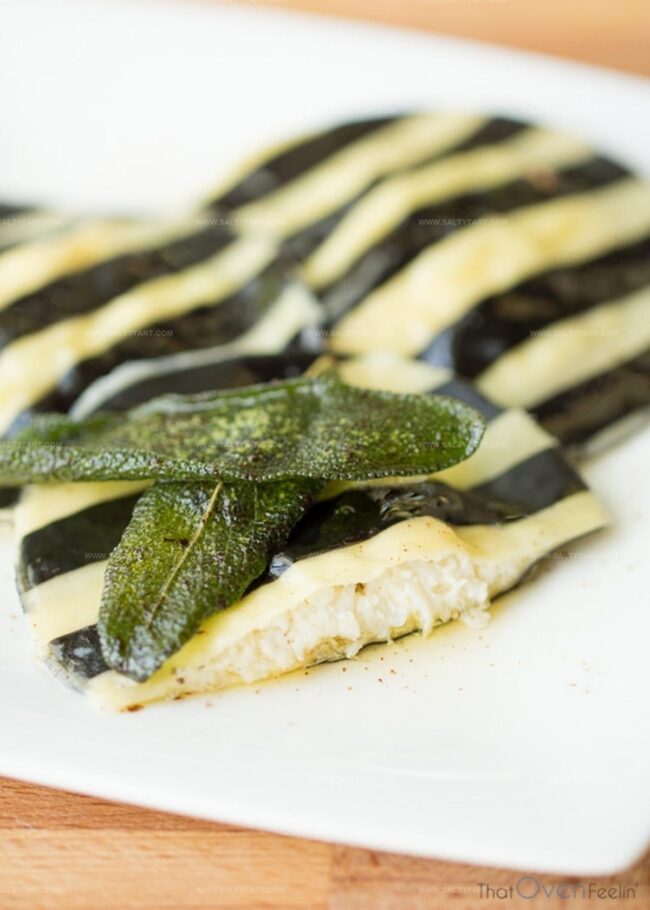
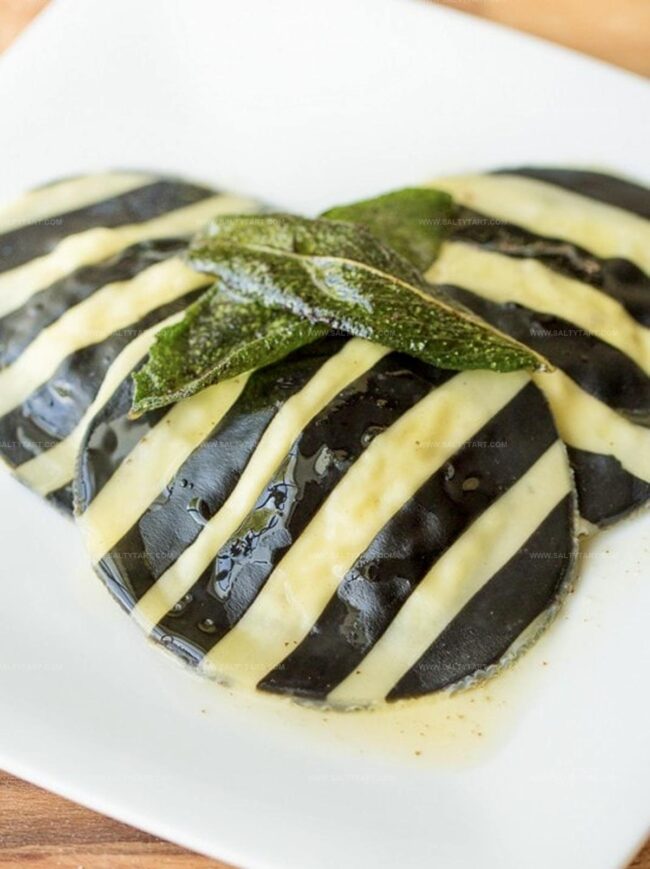
Mike Reynolds
Founder & Recipe Developer
Expertise
Farm-to-table cuisine, Seasonal recipe development, Sustainable cooking techniques, Food photography
Education
Asheville-Buncombe Technical Community College (A-B Tech)
Associate Degree in Culinary Arts
Mike studied culinary arts with a strong focus on farm-to-table principles and sustainable cooking. His training emphasized the importance of fresh, local ingredients and environmentally responsible practices in the kitchen.
Mike’s food journey began deep in the Blue Ridge Mountains, where weekends at farmers’ markets and home-cooked meals sparked a lifelong obsession with simple, seasonal eating.
After earning his Associate Degree in Culinary Arts from Asheville-Buncombe Technical Community College, he set out to bring farm-to-table cooking into everyday kitchens, without the fuss.
Mike’s philosophy is all about keeping it fresh, unfussy, and full of heart. When he’s not crafting new single-serving recipes, he’s hiking mountain trails, chatting with local farmers, or experimenting with wild ingredients in his backyard kitchen.